The Guitar Fretboard Explained
December 12th, 2023
But the good news is that with some patience and dedication, you can feel at ease moving around the fretboard. This won’t happen overnight, but it also won’t be as hard as you think.
Here’s the guitar fretboard explained!
The Strings
The guitar strings, from lowest to highest in pitch, are E, A, D, G, B, and E. If you want to understand the fretboard, you’ll want to start by memorizing these open strings.
Start by reciting them in order (EADGBE), then quiz yourself by making the following flashcards:
String 6 = E
String 5 = A
String 4 = D
String 3 = G
String 2 = B
String 1 = E
Drill these flashcards until you have all the string names down pat. And if you could use more help with this, you’ll want to head to my post on Memorizing the String Names.
Start by reciting them in order (EADGBE), then quiz yourself by making the following flashcards:
String 6 = E
String 5 = A
String 4 = D
String 3 = G
String 2 = B
String 1 = E
Drill these flashcards until you have all the string names down pat. And if you could use more help with this, you’ll want to head to my post on Memorizing the String Names.
The Sequence of Notes
Once you’re familiar with the open strings, you’ll want to learn the order of the notes. This will allow you to know all the notes on any string just by knowing the open string!
Basically, there are 12 possible notes you can play in music: C, C#, D, D#, E, F, F#, G, G#, A, A#, and B.
You can equally call these notes: C, Db, D, Eb, E, F, Gb, G, Ab, A, Bb, B. Using sharps or flats is either a musical or personal preference, but Db and C# are two names for the same pitch.
These notes repeat once within each octave. That means you and your friend can both be playing C, but she may be playing an octave higher or lower, getting a different yet related sound. (The physical relationship for octaves is 2:1, meaning a C one octave higher than another C is exactly twice its pitch).
If you’re not comfortable counting the notes, I recommend you practice this. Guitarists have it easy because each half step increment (i.e. C to C# or D# to E) corresponds to a single fret distance on the same string.
This means playing up the E string, fret by fret, goes something like this:
E (open), F (fret 1), F# (2), G (3), G# (4), A (5), A# (6), B (7), C (8), C# (9), D (10), D# (11), E (12).
E (open), F (1), Gb (2), G (3), Ab (4), A (5), Bb (6), B (7), C (8), Db (9), D (10), Eb (11), E (12).
And while we’re at it, let’s take a look at the rest of the fretboard (sharps perspective):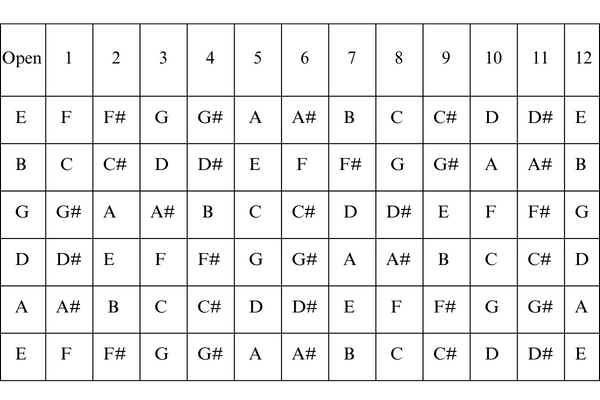
Here’s your flats perspective as well, for the sake of completeness:
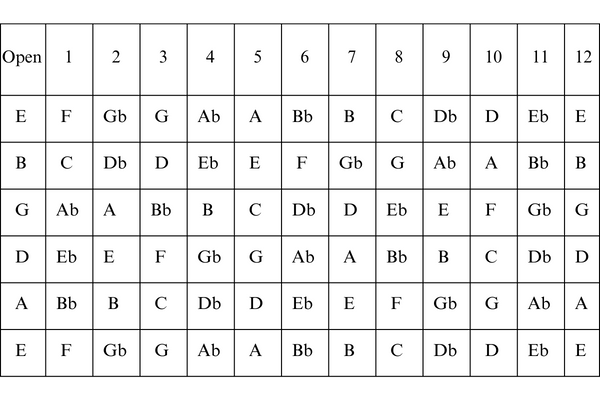
Basically, there are 12 possible notes you can play in music: C, C#, D, D#, E, F, F#, G, G#, A, A#, and B.
You can equally call these notes: C, Db, D, Eb, E, F, Gb, G, Ab, A, Bb, B. Using sharps or flats is either a musical or personal preference, but Db and C# are two names for the same pitch.
These notes repeat once within each octave. That means you and your friend can both be playing C, but she may be playing an octave higher or lower, getting a different yet related sound. (The physical relationship for octaves is 2:1, meaning a C one octave higher than another C is exactly twice its pitch).
If you’re not comfortable counting the notes, I recommend you practice this. Guitarists have it easy because each half step increment (i.e. C to C# or D# to E) corresponds to a single fret distance on the same string.
This means playing up the E string, fret by fret, goes something like this:
E (open), F (fret 1), F# (2), G (3), G# (4), A (5), A# (6), B (7), C (8), C# (9), D (10), D# (11), E (12).
Or...
E (open), F (1), Gb (2), G (3), Ab (4), A (5), Bb (6), B (7), C (8), Db (9), D (10), Eb (11), E (12).
And while we’re at it, let’s take a look at the rest of the fretboard (sharps perspective):


The Scales
Now that you know where the notes are found on the fretboard, it’s time to make sense of them. One of the best ways to do that is to learn about musical scales.
A scale is a sequential arrangement of notes that usually span one octave. The most important scales for guitarists are the major, minor, and pentatonic scales.
Learning scales is one of the best ways to get acquainted with the fretboard. But rather than memorizing established patterns, I recommend you learn the notes of the scales and then find them on the fretboard yourself.
You may think this sounds hard, but it’s a much faster way to 1) learn the scales well, and 2) master the fretboard.
Memorized patterns will take you around the grid, but they won’t provide musical context or real fretboard understanding.
The scales below are the first ones you should learn as a guitar player. Memorize them before you even play them by reciting or writing them over and over.
Also, don’t be afraid to go slow and conquer them one at a time. Once you know a scale cold, go ahead and map it out on the fretboard (refer to the diagram above for help).
Major Scales:
C major: C, D, E, F, G, A, B
G major: G, A, B, C, D, E, F#
D major: D, E, F#, G, A, B, C#
A major: A, B, C#, D, E, F#, G#
Minor Scales:
A minor: A, B, C, D, E, F, G
E minor: E, F#, G, A, B, C, D
B minor: B, C#, D, E, F#, G, A
Pentatonic Scales:
C major pentatonic: C, D, E, G, A
A minor pentatonic: A, C, D, E, G
G major pentatonic: G, A, B, D, E
E minor pentatonic: E, G, A, B, D
D major pentatonic: D, E, F#, A, B
B minor pentatonic: B, D, E, F#, A
A scale is a sequential arrangement of notes that usually span one octave. The most important scales for guitarists are the major, minor, and pentatonic scales.
Learning scales is one of the best ways to get acquainted with the fretboard. But rather than memorizing established patterns, I recommend you learn the notes of the scales and then find them on the fretboard yourself.
You may think this sounds hard, but it’s a much faster way to 1) learn the scales well, and 2) master the fretboard.
Memorized patterns will take you around the grid, but they won’t provide musical context or real fretboard understanding.
The scales below are the first ones you should learn as a guitar player. Memorize them before you even play them by reciting or writing them over and over.
Also, don’t be afraid to go slow and conquer them one at a time. Once you know a scale cold, go ahead and map it out on the fretboard (refer to the diagram above for help).
Major Scales:
C major: C, D, E, F, G, A, B
G major: G, A, B, C, D, E, F#
D major: D, E, F#, G, A, B, C#
A major: A, B, C#, D, E, F#, G#
Minor Scales:
A minor: A, B, C, D, E, F, G
E minor: E, F#, G, A, B, C, D
B minor: B, C#, D, E, F#, G, A
Pentatonic Scales:
C major pentatonic: C, D, E, G, A
A minor pentatonic: A, C, D, E, G
G major pentatonic: G, A, B, D, E
E minor pentatonic: E, G, A, B, D
D major pentatonic: D, E, F#, A, B
B minor pentatonic: B, D, E, F#, A
The Positions
A “position” on the guitar is defined by the location of your fretting hand’s index finger. That means if you’re barring the fifth fret, you’re said to be in 5th position, and when you’re strumming an open C chord, you’re in 1st position.
By far the most common position for guitarists is 1st position. You may also hear 1st position referred to as the open position, so called because this position is home to the open strings.
We can easily capture all 12 notes (and in fact play most tunes) within 1st position. So why do guitarists play in 5th, 7th, 10th, or 12th position or higher?
Here are a few reasons:
You don’t know the guitar if you don’t know 1st position. It’s where most people start (and many end) their studies, and it’s the home of all the most popular chord shapes.
Let’s take a closer look at 1st position:
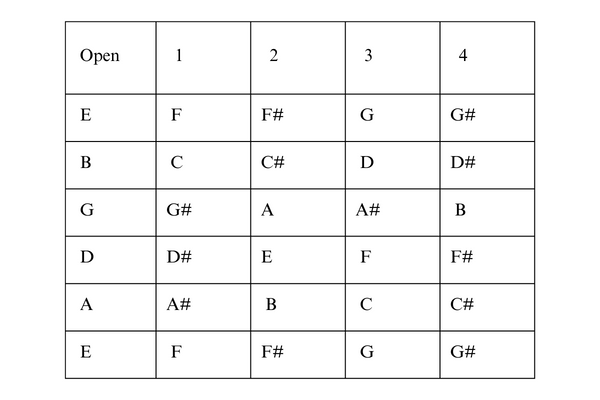
If you’re going to memorize any part of the fretboard, this is it.
Play through all these notes one by one, saying them to yourself out loud. Print out a sheet of blank 5x7 tables and practice filling them out as above.
However you do it, you’ll be a huge step ahead if you know this note-scape like the back of your hand. Once you do, any key you want to play in will be right there for you.
After 1st position, the most important region of the guitar is probably 5th position.
It offers a different set of scale and chord fingerings, higher possible pitches, and most players find it comfortable from a technical standpoint.
Here’s 5th position at a glance:
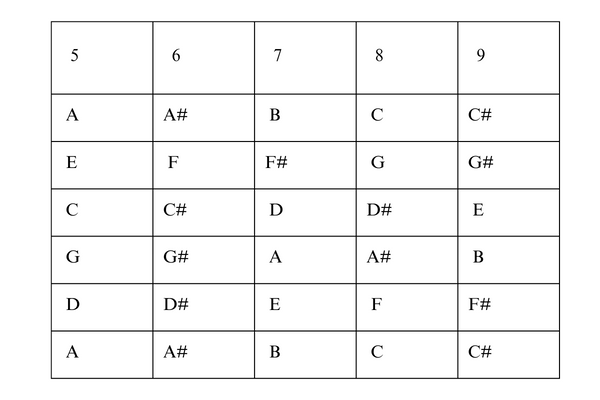
If you’re working on barre chords, you’ll almost certainly find that positions 5-7 are much more comfortable for barring than positions 1-3. But don’t take it from me—try it yourself!
Once you know the open position and 5th position, you pretty much know the entire fretboard. I can confidently say that you’re rarely going to be playing higher up on the neck.
One thing I want to note: you may have noticed that I included the ninth fret in 5th position even though our fretting hand is normally positioned as follows: index (fret 5), middle (6), ring (7), pinky (8).
See, your pinky is going to do double-duty here. It’s generally going to cover the eighth fret, but it’s also going to reach over and snag some of those juicy sharps on the ninth fret when it needs to.
Similarly, your index finger is going to cover occasional fourth fret notes. So your fretting-hand’s range is basically six frets total, especially above the fifth fret when the spaces get smaller.
But if you do decide to venture into nosebleed territory, you might as well go prepared. 9th position is seriously high—especially if you’re on an acoustic, non-cutaway guitar. But sometimes you’ve gotta do what you’ve gotta do.
Here’s 9th position:
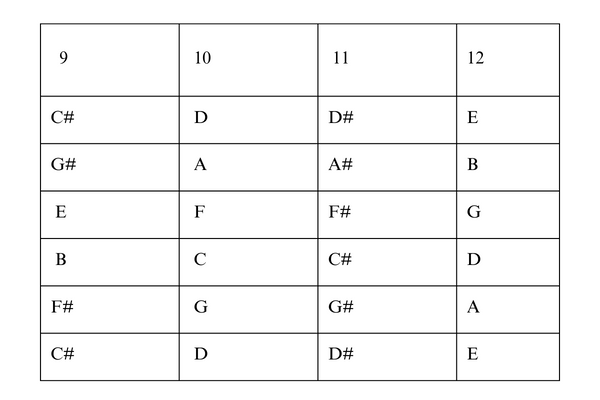
Notice that some positions are more inclined toward certain keys or scales.
For instance, if you’re playing in C major, the open position (EADGBE) is a great place to be because all those open notes are in the key.
However, if you’re playing in C# major (where every note is sharped), you’ll do much better around fret 11, where all those sharps are right there. Do your best to position yourself where it makes sense with what you’re playing.
By far the most common position for guitarists is 1st position. You may also hear 1st position referred to as the open position, so called because this position is home to the open strings.
We can easily capture all 12 notes (and in fact play most tunes) within 1st position. So why do guitarists play in 5th, 7th, 10th, or 12th position or higher?
Here are a few reasons:
- To play the highest notes on the guitar. Any note higher than the G# on the first string can’t be reached in 1st position.
- To play certain chords in certain ways. Some specific chords or inversions can only be played in higher positions because of the structure of the guitar grid.
- To avoid the open strings. Electric guitarists often dislike the distracting ringing of the open strings, preferring to play chords and scales in 5th position or higher.
- To reduce technical difficulty. Some music that sits awkwardly in 1st position is a total breeze in 7th position—it pays to know the fretboard.
1st Position
You don’t know the guitar if you don’t know 1st position. It’s where most people start (and many end) their studies, and it’s the home of all the most popular chord shapes.
Let’s take a closer look at 1st position:

If you’re going to memorize any part of the fretboard, this is it.
Play through all these notes one by one, saying them to yourself out loud. Print out a sheet of blank 5x7 tables and practice filling them out as above.
However you do it, you’ll be a huge step ahead if you know this note-scape like the back of your hand. Once you do, any key you want to play in will be right there for you.
5th Position
After 1st position, the most important region of the guitar is probably 5th position.
It offers a different set of scale and chord fingerings, higher possible pitches, and most players find it comfortable from a technical standpoint.
Here’s 5th position at a glance:

If you’re working on barre chords, you’ll almost certainly find that positions 5-7 are much more comfortable for barring than positions 1-3. But don’t take it from me—try it yourself!
Once you know the open position and 5th position, you pretty much know the entire fretboard. I can confidently say that you’re rarely going to be playing higher up on the neck.
One thing I want to note: you may have noticed that I included the ninth fret in 5th position even though our fretting hand is normally positioned as follows: index (fret 5), middle (6), ring (7), pinky (8).
See, your pinky is going to do double-duty here. It’s generally going to cover the eighth fret, but it’s also going to reach over and snag some of those juicy sharps on the ninth fret when it needs to.
Similarly, your index finger is going to cover occasional fourth fret notes. So your fretting-hand’s range is basically six frets total, especially above the fifth fret when the spaces get smaller.
9th Position
But if you do decide to venture into nosebleed territory, you might as well go prepared. 9th position is seriously high—especially if you’re on an acoustic, non-cutaway guitar. But sometimes you’ve gotta do what you’ve gotta do.
Here’s 9th position:

Notice that some positions are more inclined toward certain keys or scales.
For instance, if you’re playing in C major, the open position (EADGBE) is a great place to be because all those open notes are in the key.
However, if you’re playing in C# major (where every note is sharped), you’ll do much better around fret 11, where all those sharps are right there. Do your best to position yourself where it makes sense with what you’re playing.
Fretboard Learning Tricks
- Memorize the E string first. You’ll have two strings down once you know it!
- Realize that the open strings are the exact same as the notes on the 12th fret (but one octave higher in pitch).
- Memorize certain frets as reference points. The 5th fret is an excellent reference point since it’s roughly in the middle of the grid.
- Realize that notes on the 5th fret are the exact same is the open string below it. There are two exceptions, however: the high E has no string below it, and the 2nd open string is B, while the 3rd string is C at the fifth fret.
- Aim to know each fret (i.e. 1st fret = F, A#, D#, G#, C, F low to high) in a vertical sense and each string in a horizontal sense.
- Make flashcards and quiz yourself! Example card: 1st string C / Fret 8.
- Speak your scales. Say every note aloud when you’re playing through a pattern.
Conclusion
I hope my explanation of the guitar fretboard made at least some sense to you. You may still be a bit confused, and that’s OK.
Learning all these notes and positions will take some time. How much time largely depends on you, on your personal commitment and dedication. But you can cut down that time by reading my other post on How to Learn the Guitar Fretboard.
My other tip for you is to do as much sight-reading as possible. Be sure to check out my post on Sight-Reading for Guitarists.
Best of luck getting the lay of the land!
Learning all these notes and positions will take some time. How much time largely depends on you, on your personal commitment and dedication. But you can cut down that time by reading my other post on How to Learn the Guitar Fretboard.
My other tip for you is to do as much sight-reading as possible. Be sure to check out my post on Sight-Reading for Guitarists.
Best of luck getting the lay of the land!